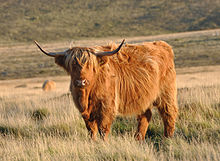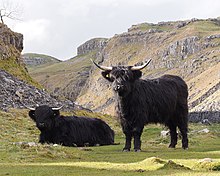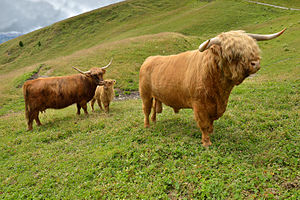What Animal Looks Like a Scottish Highlander Buffalo Cross
What Animal Looks Like a Scottish Highlander Buffalo Cross
 A Highland moo-cow on Dartmoor in England | |
| Conservation status | |
|---|---|
| Other names |
|
| Country of origin | Scotland |
| Distribution | worldwide |
| Standard | The Highland Cattle Social club |
| Use | meat |
| Traits | |
| Weight | |
| Height | |
| Coat |
|
| Horn status | horned in both sexes |
| |
The Highland (Scottish Gaelic: Bò Ghàidhealach; Scots: Hielan coo) is a Scottish breed of rustic cattle. It originated in the Scottish Highlands and the Outer Hebrides islands of Scotland and has long horns and a long shaggy coat. It is a hardy breed, able to withstand the intemperate conditions in the region. The first herd-book dates from 1885; 2 types – a smaller island blazon, usually black, and a larger mainland blazon, usually dun – were registered as a single breed. It is reared primarily for beef, and has been exported to several other countries. [4]
History [ edit ]
Highland cattle descend from the Hamitic Longhorn, which were brought to Britain by Neolithic farmers in the 2d millennium BC, every bit the cattle migrated northwards through Africa and Europe. [5] Highland cattle were historically of slap-up importance to the economy, with the cattle existence raised for meat primarily and sold in England. [vi]
The 1885 herd book describes two singled-out types of Highland cattle. One was the West Highland, or Kyloe, originating and living generally in the Outer Hebrides, which had harsher weather.[ citation needed ] These cattle tended to be smaller, to have black coats and, due to their more rugged environment, to have long pilus. [7] [8] These cattle were named due to the practice of relocating them. The kyles are narrow straits of water, and the cattle were driven across them to get to marketplace. [6]
The other blazon was the mainland; these tended to be larger considering their pastures provided richer nutrients. They came in a range of colours, well-nigh frequently dun or red. [9] These types have now been crossbred so that at that place is no singled-out divergence.
Since the early on 20th century, convenance stock has been exported to many parts of the world, especially Australia and North America.
Information technology is estimated that at that place are now around 15,000 Highland cattle in the United Kingdom. [eight]
Scotland [ edit ]
Originally, small farmers kept Highlands every bit house cows to produce milk and for meat. [10] The Highland cattle registry ("herd book") was established in 1885. Although a group of cattle is generally chosen a herd, a group of Highland cattle is known as a "fold". This is because in winter, the cattle were kept in open shelters made of stone called folds to protect them from the weather at night. [eleven] They were too known every bit kyloes in Scots. [12]
In 1954, Queen Elizabeth ordered Highland cattle to be kept at Balmoral Castle where they are still kept today. [13] [fourteen]
Australia [ edit ]
Highland cattle were first imported into Australia by the mid-19th century by Scottish migrants such every bit Chieftain Aeneas Ronaldson MacDonell of Glengarry, Scotland. Arriving in Port Albert, Victoria, in 1841 with his clan, they apparently drove their Highland cattle to a farm at Greenmount, on the Tarra River, preceded by a piper. Samuel Amess, also from Scotland, who fabricated a fortune in the Victorian goldfields and became Mayor of Melbourne in 1869, kept a minor fold of black Highland cattle on Churchill Island. They were seen and survived in Port Victoria during the belatedly 1800s, merely other folds were believed to take died out in areas such as New South Wales. In 1988 the Australian Highland Cattle Social club was formed. Since then, numbers have been growing and semen is being exported to New Zealand to establish the brood at that place.
Canada [ edit ]
Highland cattle were first imported into Canada in the 1880s. The Hon. Donald A. Smith, Lord Strathcona of Winnipeg, Manitoba, and Robert Campbell of Strathclair, Manitoba, imported one bull each. There were too Highland cattle in Nova Scotia in the 1880s. [xv] Yet, their numbers were small until the 1920s when large-calibration convenance and importing began. [16] In the 1950s cattle were imported from and exported to Due north America. The Canadian Highland Cattle Order was officially registered in 1964 and currently registers all purebred cattle in Canada. [17] Towards the stop of the 1990s, there was a large semen and embryo trade between the UK and Canada. However that has stopped, largely due to the BSE (mad cow disease) outbreaks in the Britain. Today, Highland cattle are mainly constitute in eastern Canada. [18] The population of Highland cattle for Canada and the Usa combined is estimated at 11,000. [eight]
Denmark [ edit ]
The Danish Highland Cattle Society was established in 1987 to promote the best practices for the breeding and care of Highland cattle and to promote the introduction of the breed into Denmark. [19]
Finland [ edit ]
The Highland Cattle Lodge of Finland was founded in 1997. Their studbooks prove importation of Highland cattle breeding stock to Finland, dating back to 1884. The Finnish club states that in 2016, at that place were thirteen,000 Highland cattle in Finland. [twenty]
United states of america [ edit ]
The first record of Highland cattle beingness imported to the United States was in the tardily 1890s. [21] The American Highland Cattle Clan was commencement organised in 1948 as the American Scotch Highland Breeders Association, and now claims approximately 1100 members. [22] There are now 8 regional Highland cattle associations in the U.South. as well.
Characteristics [ edit ]
They have long, wide horns and long, wavy, woolly coats. The usual coat colour is reddish brown, seen in approximately 60% of the population; some 22% are yellow, and the remainder stake silver, blackness or brindle/dun. [23] : 200 The coat colours are acquired by alleles at the MC1R gene (E locus) and the PMEL or SILV gene (D locus). [24]
They have an unusual double glaze of hair. On the outside is the oily outer hair—the longest of any cattle breed, covering a downy undercoat. [25] This makes them well suited to weather condition in the Highlands, which have a high almanac rainfall and sometimes very potent winds. [26]
Their skill in foraging for food allows them to survive in steep mountain areas where they both graze and eat plants that many other cattle avoid. They tin can dig through the snow with their horns to find buried plants. [27]
Mature bulls can counterbalance upward to 800 kilograms (ane,800 pounds) and heifers can weigh up to 500 kilograms (one,100 pounds). Cows typically accept a height of 90–106 centimetres (3–three.5 ft), and bulls are typically in the range of 106–120 centimetres (3.5–4 ft).[ citation needed ] Mating occurs throughout the year with a gestation menses of approximately 277–290 days. Nigh unremarkably a single calf is born, merely twins are not unknown. Sexual maturity is reached at virtually 18 months. Highland cattle besides accept a longer expected lifespan than most other breeds of cattle, upward to 20 years. [28]
Cold tolerance [ edit ]
All European cattle cope relatively well with low temperatures only Highland cattle have been described every bit "near as cold-tolerant every bit the arctic-dwelling caribou and reindeer". [29] Conversely due to their thick coats they are much less tolerant of rut than zebu cattle, which originated in South Asia and are adapted for hot climates. [30] Highland cattle have been successfully established in countries where winters are substantially colder than Scotland such as Norway and Canada. [31]
[ edit ]
A fold of semi-wild Highland cattle was studied over a period of 4 years. It was plant that the cattle take a clear structure and hierarchy of dominance, which reduces aggression. Social standing depends on age and sex, with older cattle existence dominant to calves and younger ones, and males dominant to females. Immature bulls will dominate developed cows when they reached around 2 years of age. Calves from the pinnacle ranking cow were given higher social status, despite minimal intervention from their mother. Playfighting, licking and mounting were seen every bit friendly contact. [32] [33]
Convenance occurred in May and June, with heifers first giving birth at 2–3 years old. [32]
Highland cattle bull, cow and calf on mountain Secëda in Val Gardena, northern Italian republic
- Head
- Proportionate to body
- Wide between eyes
- Must naturally have horns, [10] but may exist trimmed in commercial rearing
- Neck
- Clear, without dewlap
- Straight line to body
- Back and torso
- The back must exist rounded
- The quarters must be wider than the hips
- The legs must be short and straight
- Hair
- The hair must be straight and waved
Sources: Highland Cattle Social club, [4]
Use [ edit ]
The meat of Highland cattle tends to be leaner than most beefiness considering Highlands are largely insulated by their thick, shaggy hair rather than by subcutaneous fat. Highland cattle can produce beef at a reasonable profit from land that would otherwise ordinarily exist unsuitable for agronomics. The nearly profitable way to produce Highland beef is on poor pasture in their native state, the Highlands of Scotland. [9] [34] The meat is as well gaining popularity in North America as the beef is depression in cholesterol. [27]
Commercial success [ edit ]
The beef from Highland cattle is very tender, but the market for loftier-quality meat has declined. To address this decline, it is common practise to breed Highland "suckler" cows with a more favourable brood such every bit a Shorthorn or Limousin balderdash. This allows the Highland cattle to produce a crossbred beef dogie that has the tender beef of its mother on a carcass shape of more commercial value at slaughter. [35] These crossbred beefiness suckler cows inherit the hardiness, thrift and mothering capabilities of their Highland dams and the improved carcass configuration of their sires. Such crossbred sucklers tin can be further crossbred with a modern beef bull such as a Limousin or Charolais to produce high quality beefiness. [12]
Showing [ edit ]
For bear witness purposes, Highland cattle are sometimes clean-cut with oils and conditioners to give their coats a fluffy appearance that is more apparent in calves; it leads some outside the industry to telephone call them "fluffy cows". [36] Many besides telephone call the cows "hairy cows" due to their thick coats. [27] [37]
Encounter also [ edit ]
References [ edit ]
- ^ Barbara Rischkowsky, Dafydd Pilling (editors) (2007). List of breeds documented in the Global Databank for Animal Genetic Resources, annex to The State of the World's Animal Genetic Resources for Food and Agronomics . Rome: Commission on Genetic Resources for Food and Agronomics, Food and Agriculture Organization of the Un. ISBN9789251057629. Archived 23 June 2022.
- ^ a b c d e Breed information sheet: Highland / United Kingdom of Great United kingdom and Northern Republic of ireland (Cattle). Domestic Animal Diverseness Information System of the Food and Agriculture Organization of the United Nations. Accessed Dec 2022.
- ^ Watchlist overview. Kenilworth, Warwickshire: Rare Breeds Survival Trust. Accessed Dec 2022.
- ^ a b "Highland Cattle Guild breed standard". Highlandcattlesociety.com. Retrieved thirteen June 2016.
- ^ Baker, J.R.; Muller, R (1982). Advances in Parasitology . Academic Press. p. 5. ISBN 978-0-08-058067-8 – via Google Books.
- ^ a b Dohner, Janet Vorwald (2001). The Encyclopedia of Celebrated and Endangered Livestock and Poultry Breeds . Yale Academy Press. pp. 243–five. ISBN 978-0-300-13813-9 .
- ^ James Wilson (1909), "ch. Viii The Colours of Highland Cattle", The Scientific Proceedings of the Royal Dublin Society, Royal Dublin Society
- ^ a b c "Highland cattle – Mother Earth News". Mother Earth News. p. four. Retrieved thirty May 2015.
- ^ a b "Highland Cattle USA – The Breed" . Retrieved 11 September 2015.
- ^ a b "NWHCA Highland cattle". Northwest Highland Cattle Clan. Retrieved 13 June 2016.
- ^ "Smallholder Serial – Cattle Breeds" . Retrieved 13 June 2015.
- ^ a b "Highland Cattle Social club; the breed". The Highland Cattle Guild. Retrieved 13 June 2016.
- ^ "Highland Cattle at Balmoral Castle" . Retrieved 7 June 2015.
- ^ "Queen to found Highland Cattle fold". Glasgow Herald. 25 Feb 1954. Retrieved xi September 2015 – via Google Books.
- ^ "Livestock Salvation – Highland cattle" . Retrieved 4 August 2015.
- ^ "Highland Cattle history in Canada". Canadian Highland Cattle Society. Archived from the original on 29 April 2015. Retrieved 28 April 2015.
- ^ "Canadian Highland Cattle Lodge" . Retrieved 28 May 2015.
- ^ "Highland Cattle World – Canada". Highland Cattle World . Retrieved 28 May 2015.
- ^ "Danish Highland Cattle Social club About". highland-cattle.dk . Retrieved 4 December 2016.
- ^ "SHCC ry". Suomen Highland Cattle Club ry. (in Finnish). Retrieved 4 September 2016.
- ^ "American Highland Cattle Brood History" . Retrieved 7 February 2022.
- ^ "American Highland Cattle Association History" . Retrieved 7 February 2022.
- ^ Valerie Porter, Lawrence Alderson, Stephen J.Yard. Hall, D. Phillip Sponenberg (2016). Bricklayer's Earth Encyclopedia of Livestock Breeds and Breeding (sixth edition). Wallingford: CABI. ISBN9781780647944.
- ^ Schmutz, S. M.; Dreger, D. Fifty. (2013). "Interaction of MC1R and PMEL alleles on solid coat colors in Highland cattle". Anim Genet. 44 (one): nine–13. doi:10.1111/j.1365-2052.2012.02361.x. PMID22524257.
- ^ "Highland Cattle in Alberta". The Alberta Beef Magazine. April 2006.
- ^ "Highland cattle – Britannic Rare Breeds" . Retrieved 11 September 2015.
- ^ a b c "Highland cattle and their mural". A to Z Animals. Retrieved 13 June 2016.
- ^ "Highland Cattle – Ocean World". seaworld.org . Retrieved 22 June 2015.
- ^ Campbell, John R; Douglas Kenealy, Grand.; Campbell, Karen L. (2009). Animate being Sciences: The Biology, Care, and Production of Domestic Animals (4th ed.). Waveland Press. p. 299. ISBN 978-1-4786-0821-9 .
- ^ Serif, S. M.; Johnson, H. D.; Lippincott, A. C. (March 1979). "The effects of oestrus exposure (31 °C) on zebu and Scottish Highland cattle". International Journal of Biometeorology. 23 (1): 9–fourteen. Bibcode:1979IJBm...23....9S. doi:10.1007/BF01553372. PMID500248. S2CID33123426.
- ^ Porter, Valerie; Alderson, Lawrence; Hall, Stephen J. G.; Sponenberg, Phillip (2016). Mason's World Encyclopedia of Livestock Breeds and Breeding. CAB International. p. 200. ISBN 978-1-84593-466-eight .
- ^ a b Reinhardt, Catherine; et al. (28 February 1985). "Social behaviour and reproductive performance in semi-wild Scottish Highland cattle". Applied Animal Behaviour Science. fifteen (2): 125–136. doi:ten.1016/0168-1591(86)90058-4 . Retrieved 26 August 2015.
- ^ Clutton-Brock, T. H.; Greenwood, P. J.; Powell, R. P. (1976). "Ranks and Relationships in Highland Ponies and Highland Cows". Zeitschrift für Tierpsychologie. 41 (ii): 206–216. doi:ten.1111/j.1439-0310.1976.tb00477.10. PMID961125.
- ^ "North Due east Highland Cattle – Nearly the Breed" (PDF). Archived from the original (PDF) on 7 December 2015. Retrieved xiv September 2015.
- ^ "Highland cattle suckler beef". The British Charolais Cattle Society. Retrieved 15 September 2015.
- ^ "Fluffy cows: Old Dazzler practise gains attending". Associated Press. Retrieved 13 June 2016.
- ^ "Association MacGregor – Highland cattle information". Clan MacGregor . Retrieved six September 2015.
Further reading [ edit ]
- James Wilson (1909), "ch. 8 The Colours of Highland Cattle", The Scientific Proceedings of the Regal Dublin Order, Royal Dublin Society
- Schmutz, S. Grand.; Dreger, D. L. (2013). "Interaction of MC1R and SILV alleles on solid coat colors in Highland Cattle". Animal Genetics. 44 (1): 9–13. doi:x.1111/j.1365-2052.2012.02361.ten. PMID22524257.
- Reinhardt, Catherine; et al. (1986). "Social behaviour and reproductive performance in semi-wild Scottish Highland cattle". Applied Beast Behaviour Science. xv (2): 125–136. doi:10.1016/0168-1591(86)90058-4.
- Clutton-Brock, T. H.; Greenwood, P. J.; Powell, R. P. (1976). "Ranks and Relationships in Highland Ponies and Highland Cows". Zeitschrift für Tierpsychologie. 41 (two): 202–216. doi:x.1111/j.1439-0310.1976.tb00477.x. PMID961125.
What Animal Looks Like a Scottish Highlander Buffalo Cross
Source: https://en.wikipedia.org/wiki/Highland_cattle











Comments
Post a Comment